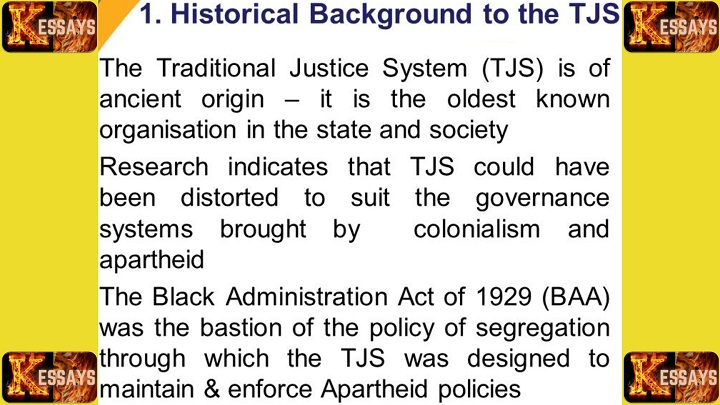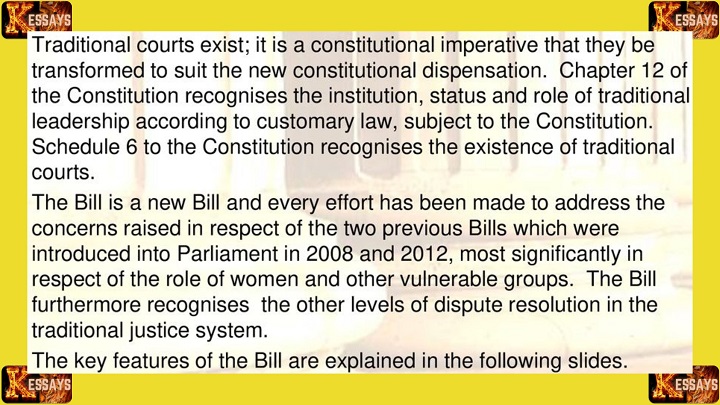Introduction
The traditional criminal justice system is a cornerstone of societies worldwide, designed to maintain order, protect communities, and ensure justice for victims and offenders. This system is rooted in historical principles and legal frameworks and encompasses the investigation, prosecution, and adjudication of criminal offenses. This essay explores the components, processes, and principles of the traditional criminal justice system, its role in society, and its potential strengths and limitations.
I. Understanding the Traditional Criminal Justice System
1.1. Definition and Scope
The traditional criminal justice system refers to the set of institutions, laws, and procedures established to identify, apprehend, prosecute, and adjudicate individuals accused of committing criminal offenses. It encompasses law enforcement agencies, courts, and correctional facilities that work collaboratively to uphold the rule of law and maintain public safety.
1.2. Components of the Traditional Criminal Justice System
The traditional criminal justice system comprises three main components:
- Law Enforcement: Law enforcement agencies, including police departments, play a pivotal role in the system. They are responsible for investigating alleged criminal activities, gathering evidence, and apprehending suspects.
- Courts: Courts are the venues where criminal cases are adjudicated. Judges preside over trials, weigh evidence, and determine guilt or innocence. They also impose sentences on convicted individuals.
- Corrections: Correctional facilities, such as prisons and jails, are responsible for incarcerating convicted offenders and providing rehabilitation programs to aid in their reintegration into society.

II. The Criminal Justice Process
2.1. Investigation and Arrest
The criminal justice process commences with law enforcement conducting investigations based on reports of criminal activity or evidence gathered from the scene. If sufficient evidence exists, suspects are arrested and informed of their rights.
2.2. Charging and Arraignment
Once arrested, suspects are formally charged with specific criminal offenses. They are brought before a judge during an arraignment, where they enter a plea of guilty or not guilty.
2.3. Trial and Adjudication
Those who plead not guilty proceed to trial, during which evidence is presented, witnesses testify, and legal arguments are made. A jury or judge assesses the evidence to determine guilt or innocence.
2.4. Sentencing and Punishment
If found guilty, the offender is sentenced by the judge, taking into account the nature of the crime, the offender's criminal history, and other relevant factors. Sentences can range from fines and probation to imprisonment or even the death penalty, depending on the severity of the offense and applicable laws.
III. Principles of the Traditional Criminal Justice System
3.1. Presumption of Innocence
One of the fundamental principles of the traditional criminal justice system is the presumption of innocence. Until proven guilty beyond a reasonable doubt, individuals accused of crimes are considered innocent. This principle protects the rights of the accused and ensures fair treatment during the legal process.
3.2. Due Process
Due process guarantees that individuals accused of crimes have the right to a fair and impartial trial. This includes the right to legal representation, the right to remain silent, and the right to confront witnesses against them. Due process safeguards against arbitrary arrests and convictions, promoting the principles of justice and fairness.
3.3. Proportionality
The principle of proportionality dictates that the punishment for a crime should be commensurate with the severity of the offense. Sentences are intended to be proportionate and just, preventing overly harsh or excessively lenient punishments.
IV. Role of the Traditional Criminal Justice System in Society
4.1. Upholding Law and Order
The primary role of the traditional criminal justice system is to uphold the rule of law and maintain order within society. By investigating and prosecuting criminal offenses, the system seeks to deter criminal behavior and protect communities from harm.
4.2. Protecting the Rights of Victims
The criminal justice system seeks to protect the rights of victims by holding offenders accountable for their actions. Victims have the opportunity to participate in the legal process, share their impact statements, and seek restitution or justice for the harm they have endured.
4.3. Rehabilitating Offenders
In addition to punishment, the traditional criminal justice system aims to rehabilitate offenders and reduce the likelihood of recidivism. Correctional facilities provide various programs, such as educational courses and counseling, to address the underlying causes of criminal behavior and prepare offenders for reintegration into society.
4.4. Promoting Deterrence
The traditional criminal justice system serves as a deterrent against criminal behavior. The knowledge of potential legal consequences, such as imprisonment or fines, discourages individuals from engaging in criminal acts, thereby contributing to the prevention of crime.
4.5. Providing Closure and Resolution
For victims and their families, the criminal justice system provides closure and resolution by addressing the harm caused by the offense. Through the legal process, victims have the opportunity to see the offender held accountable, which can offer a sense of justice and closure.
4.6. Maintaining Social Order
By enforcing laws and holding individuals accountable for their actions, the traditional criminal justice system helps maintain social order and stability. This fosters trust and confidence in the legal system, promoting a sense of security within society.
4.7. Promoting Public Safety
The criminal justice system plays a vital role in promoting public safety. By apprehending and incarcerating dangerous offenders, it protects the community from further harm and reduces the risk of repeat offenses.
4.8. Resolving Disputes and Conflict
In addition to addressing criminal offenses, the traditional criminal justice system helps resolve disputes and conflicts among individuals or parties. It provides a forum for resolving legal disagreements through civil cases and alternative dispute resolution methods.
4.9. Contributing to Community Reintegration
Through various rehabilitation programs, the criminal justice system supports the successful reintegration of offenders into society. By providing education, job training, and counseling, it aims to reduce recidivism and facilitate a smooth transition for individuals returning to their communities after serving their sentences.
4.10. Serving as a Deterrent for Potential Offenders
The existence and effectiveness of the traditional criminal justice system act as a deterrent for potential offenders. The knowledge that criminal acts are subject to investigation, prosecution, and punishment discourages individuals from engaging in illegal activities.
- The traditional criminal justice system plays a multifaceted role in society, encompassing the maintenance of law and order, protection of victims' rights, rehabilitation of offenders, and promotion of public safety. By upholding the rule of law and ensuring due process, it serves as a cornerstone of justice and accountability.
Despite its strengths, the system also faces challenges and criticisms, which necessitate ongoing evaluation and improvement to better meet the evolving needs of communities and individuals involved in the criminal justice process. Through a balanced approach that emphasizes fairness, rehabilitation, and public safety, the traditional criminal justice system can continue to fulfill its essential role in safeguarding society and seeking justice for all.

V. Strengths and Limitations of the Traditional Criminal Justice System
5.1. Strengths
- Established Framework: The traditional criminal justice system is deeply rooted in legal principles, providing a structured and well-defined process for addressing criminal offenses.
- Due Process: The emphasis on due process ensures that individuals accused of crimes receive fair and impartial treatment throughout the legal proceedings.
- Deterrence: The system serves as a deterrent against criminal behavior, as potential offenders are aware of the consequences of their actions.
- Preservation of Social Order: The traditional criminal justice system plays a vital role in preserving social order and stability within communities. By addressing criminal behavior and imposing consequences for illegal acts, it sends a message that unlawful conduct will not be tolerated, thereby deterring potential offenders.
- Accountability and Responsibility: Through the traditional criminal justice system, individuals are held accountable for their actions. This accountability promotes a sense of responsibility for one's behavior and actions, reinforcing the idea that every individual is responsible for the consequences of their choices.
- Protection of Individual Rights: The system upholds and protects the rights of both victims and the accused. It ensures that victims' rights to safety, restitution, and justice are respected, while also safeguarding the rights of the accused, including the right to legal representation and a fair trial.
- Closure for Victims: For victims of crime, the traditional criminal justice system provides a path to closure and healing. By seeking justice for victims and holding offenders accountable, the system offers an opportunity for victims to find a sense of closure and resolution after experiencing harm.
- Retributive Justice: The traditional criminal justice system aligns with the concept of retributive justice, which advocates for punishment proportionate to the harm caused. This approach satisfies society's need for redress and reinforces the belief that offenders should face consequences for their actions.
- Public Confidence and Trust: A well-functioning traditional criminal justice system fosters public confidence and trust in the legal system. When individuals perceive the system as fair, transparent, and effective, they are more likely to cooperate with law enforcement, support the legal process, and have faith in the rule of law.
- Clarity in Legal Proceedings: The system follows a formalized legal process with clear rules and procedures, ensuring that legal proceedings are conducted in a systematic and organized manner. This clarity facilitates the smooth functioning of the system and reduces the likelihood of arbitrary decision-making.
- Focus on Community Safety: By addressing criminal behavior, the traditional criminal justice system contributes to community safety. Through the incarceration of dangerous offenders and rehabilitation efforts, it seeks to prevent further harm to the community and its members.
- Cultural and Historical Continuity: The traditional criminal justice system often reflects the cultural and historical values of a society. Its continuity and adherence to established legal principles and practices can reinforce a sense of cultural identity and historical continuity within a community or nation.
5.2. Limitations
- Overburdened Courts: The court system can become overwhelmed with a high volume of cases, leading to delays in the legal process and potential backlogs.
- Focus on Punishment: Critics argue that the system's heavy reliance on punitive measures may not always effectively address the root causes of criminal behavior.
- Disparities and Inequities: In some cases, the traditional criminal justice system has been criticized for disproportionately affecting certain communities or demographics, leading to concerns about inequity.
- Lack of Emphasis on Rehabilitation: While the system aims to rehabilitate offenders, limited resources and a focus on punishment can sometimes hinder comprehensive efforts toward effective rehabilitation.
- Financial Costs: The traditional criminal justice system can be financially burdensome for both taxpayers and individuals involved in legal proceedings, including defendants who may face high legal fees.
- Potential for Wrongful Convictions: Despite due process safeguards, there is a risk of wrongful convictions in the traditional criminal justice system, which can have devastating consequences for innocent individuals.
- Limited Focus on Restorative Justice: Critics argue that the system's primary focus on punishment may overshadow the potential benefits of restorative justice approaches that prioritize healing and repairing harm caused by crime.
- Inadequate Support for Mental Health and Substance Abuse Issues: The system may not always adequately address underlying mental health or substance abuse issues contributing to criminal behavior, potentially perpetuating a cycle of recidivism.
- Limited Attention to Diversion and Alternatives to Incarceration: Some argue that the system should explore diversion programs and alternative sentencing options, particularly for non-violent offenders, to address root causes and reduce the burden on correctional facilities.
- Racial and Socioeconomic Bias: Concerns persist about racial and socioeconomic bias within the traditional criminal justice system, leading to disparities in sentencing and outcomes for marginalized communities.

Conclusion
The traditional criminal justice system plays a crucial role in maintaining law and order, protecting the rights of victims, and seeking justice for offenders. With its established framework and focus on due process, it upholds principles of fairness and accountability. However, the system is not without its challenges, such as court backlogs and concerns about punitive approaches. As societies evolve, the ongoing evaluation and improvement of the traditional criminal justice system are essential to ensure that it remains effective, just, and responsive to the needs of communities and individuals involved in criminal proceedings.



Comments are closed!